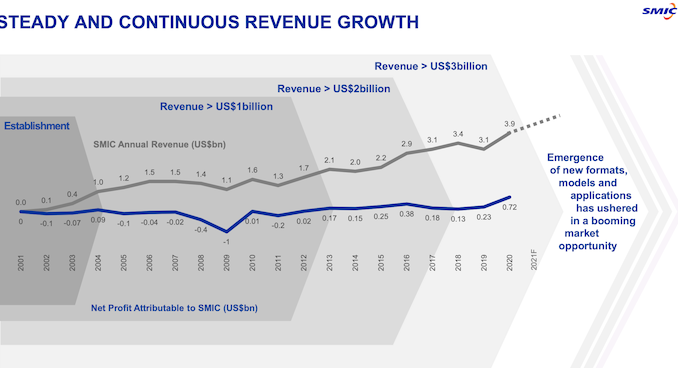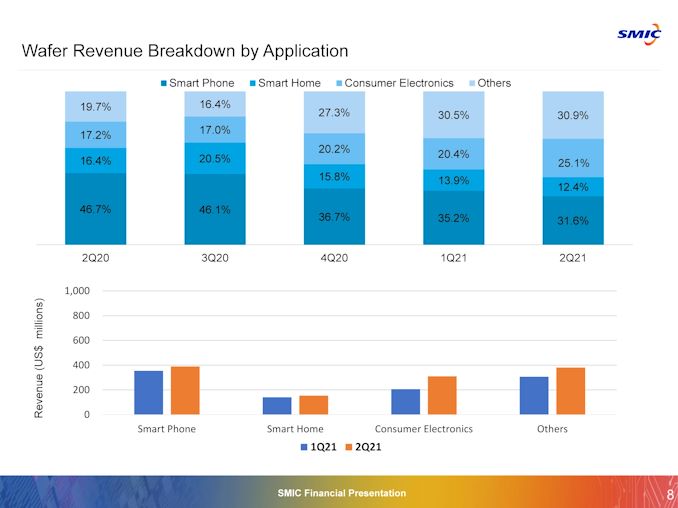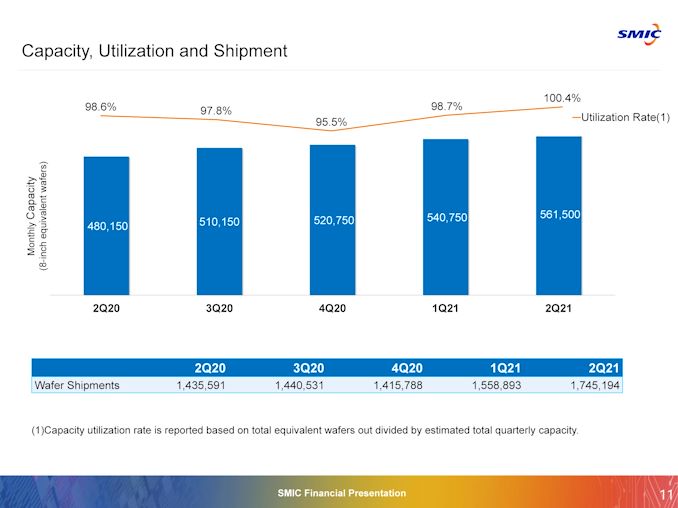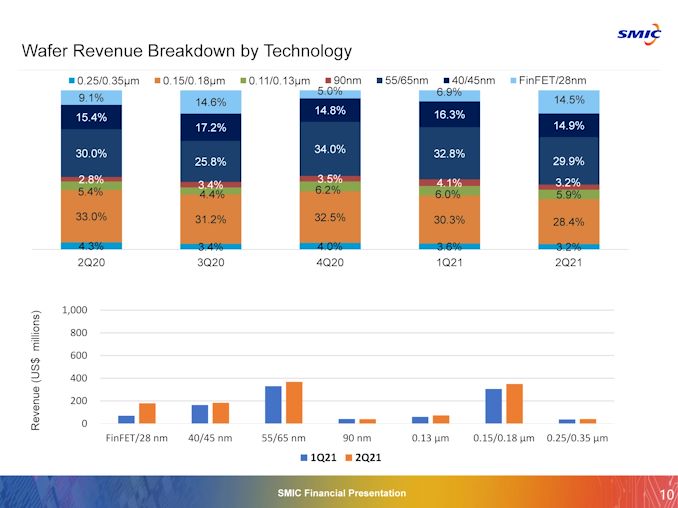China's SMIC To Build a GigaFab for $8.87B: An Answer to the Shortages
by Anton Shilov on September 6, 2021 1:30 PM EST- Posted in
- SMIC
- GlobalFoundries
- 28nm
- Wi-Fi
- TSMC
- Automotive
- DDIC
- China
- Shortage
- 45nm

As a result of being on the US Entity list, SMIC's blacklisting has caused troubles in the company developing and deploying leading-edge fabrication technologies. As a result, it has been forced to focus on mature nodes, which still have plenty of use in long-life cycle parts for electronics and the automotive industry. On Friday the company announced plans to build China's first GigaFab, a 300 mm production facility with planned capacity of around 100,000 wafer starts per month (WSPM). The fab will cost nearly $8.87 billion.
Building Up Capacity for Mature Nodes
The new fab will be located near Shanghai, in the Lingang Free Trade Zone (FTZ), and will be built as a partnership between SMIC and the Shanghai Municipal People’s Government. The fab will process 300 mm wafers using mature production technologies, such as 28 nm and above. These nodes are typically used for various chips with a very long lifecycle, and which are in short supply now. Over the past few months various leading PC makers complained about deficit of cheap components like display driver ICs (DDICs) or Wi-Fi controllers and these chips are made using 28 nm and larger nodes. Other industries, such as the automotive industry, have been crying out for new supplies - given China's rather large car market, there is pent up demand for more sources of fundamental electronic components.
SMIC did not indicate when it expects the new fab to go online, but it is reasonable to expect it to become operational two or three years down the road. Despite this the company also did not increase its CapEx of $4.3 billion for 2021 from the number it announced earlier this year, perhaps indiciating that this will be a 2022 project when it starts. Once this happens, SMIC will be able to make a significant contribution to the global supply of semiconductors produced using mature fabrication processes.
The new fab will be China's only GigaFab for logic semiconductors (it has several for DRAM, which is considered separate). Here we are using TSMC's terminology for 'GigaFab', which is a 300mm fab with a production capacity of 100,000 or more wafer starts per month.

Earlier this year SMIC initiated a project to build a 300mm fab near Shenzhen for $2.35 billion. That fab is set to eventually achieve production capacity of around 40,000 wafer starts per month and use 28 and larger fabrication technologies. This smaller fab will start operations sometimes in 2022, as semiconductor capacity demand by local companies in China is growing.
In a bid to equip both fabs, SMIC inevitably has to use equipment produced by the U.S.-based makers, such as Applied Materials, Lam Research, KLA, and Axcelis. All of them applied for export licenses to supply SMIC since the foundry is in the U.S. Department of Commerce's Entity List earlier this year. While we do not know if they were granted, the very fact that SMIC announces a fab with an unprecedented capacity (for China and SMIC) indicates that it believes it can equip its production facilities with proper equipment, either from the US or elsewhere.
As always, SMIC will share ownership of the fab with authorities, in this particular case in the Lingang Free Trade Zone with co-investors. SMIC will own a controlling 51% stake, Shanghai Municipal People’s Government will own less than 25% and the outstanding 24% will be controlled by other investors set to be 'mutually found by SMIC and the local authorities.'
Just In Time
Mature process technologies, such as 40/45 nm, 55/65 nm, and 150/180 nm have been SMIC's livelihood, so expanding capacities for 300mm based processes (anything from 28nm to 45nm - larger process nodes tend to be on 200mm wafers) makes a great sense for the company. Furthermore, the company is investing additional money in 200mm fabs that use specialized nodes (90+nm) to produce chips for mixed-signal & RF, MEMS, and PMIC applications.
Based on SMIC's financial report for Q2 2021, demand for its 28 nm technology has been fluctuating in the recent quarters, whereas demand for its 14 nm FinFET technology remained at a rather low level. It's worth noting that SMIC isn't the major 28nm player in China here - TSMC and UMC lead the market. But as more applications migrate to this node, demand for chips is increasing, and SMIC's 28 nm will account for a larger portion of its revenue, which is growing despite its restrictions.
SMIC's fab utilization rate has always been rather high, but in Q2 2021 it rose to 100.4%, which essentially means that the company had to reduce its expected time on maintenance and focus more on production. This is a risky decision, so to avoid such moves in the future, SMIC needs to expand its capacities and with two all-new fabs it is doing this rather aggressively.
SMIC does have a 14nm process node with FinFETs, and is expanding this as well. In the first half of 2020 SMIC's 14nm-capable capacity was around 4,000 WSPM (based on the company's data from back then). By now, this capacity has increased to 15,000 WSPM, according to a CnTechPost story, which has not verified by the company itself.
Not Alone
SMIC is definitely not alone with its production capacity expansion plans - GlobalFoundries, TSMC, and UMC are also financing in additional capacity for mature processes. TSMC is investing in its fab near Nanjing, China. GlobalFoundries is expanding its Fab 8 in upstate New York and is installing new equipment in its Fab 1 near Dresden Germany boost its capacity.
But with such a huge demand for chips, it is inevitable that foundries will pull in some incredible amount of cash to fund their future development, which is exactly what SMIC is doing.
Related Readiing
- SMIC to Build a New 28nm Fab in Shenzhen: Production to Start in 2022
- SMIC Details Its N+1 Process Technology: 7nm Performance in China
- SMIC Begins Volume Production of 14 nm FinFET Chips: China’s First FinFET Line
- SMIC: 14nm FinFET in Risk Production; China's First FinFET Line To Contribute Revenue by Late 2019
- SMIC To Start 14nm Mass Production in H1 2019













23 Comments
View All Comments
d0x360 - Tuesday, September 14, 2021 - link
Expertise gained by stealing information. So not true knowledge or innovation and that's china's Achilles heel.at_clucks - Wednesday, September 8, 2021 - link
The downside of imposing such blanket bans on tech for countries like China is that they're forced to develop their own tech. The end result is that the US has basically pushed China into strengthening their own semiconductor sector at accelerate pace without massively capitalizing on this period where China was crippled due to the lack of deployed capacity.Oxford Guy - Sunday, September 12, 2021 - link
China would have helped itself to the IP regardless.d0x360 - Tuesday, September 14, 2021 - link
Indeed and they also would have been pushing for home grown designs and fabrication by this point anyways. China is closing down and will start kicking any non Chinese company out ASAP. They have already begun in fact but some companies are still too important to kick out... For now.Threska - Saturday, September 25, 2021 - link
As this video shows it's not as easy as people think.https://youtu.be/isBYV6QWDIo
Current failures demonstrate that.
https://youtu.be/OZSvDYDfd78
jamesindevon - Tuesday, September 7, 2021 - link
This all reminds me of the RAM market between 1995 and 1999: due to a fire at a production facility, and most people upgrading to Windows 95 and wanting more memory, memory prices remained sky-high. The RAM manufacturers raked in the money, and invested heavily in new fabs.As the fabs started to come online, it became apparent that the world now had a lot more memory capacity than it needed. Prices of memory plummeted: some nearly-completed fabs were converted to make flash, which helped kick-start the flash-based disk market.¹
So cheer up, everyone! In two or three years time, there should be plenty of excess capacity, and fabs begging the GPU companies to push loads of juicy large chips through their fabs to make use of it.
Might not be great for the environment, though.
¹ You need ~32 MB of flash before it's reasonable to do journalling on flash; with much less than that, the erase block sizes are too large compared to the disk, so the overhead becomes unreasonable. I have somewhere a 256 KB flash disk for the Psion Series 3: as you wrote to it, it filled up, and eventually you had to copy off what you wanted to keep and format the drive.
prophet001 - Tuesday, September 7, 2021 - link
No backdoors.We promise.
Oxford Guy - Tuesday, September 7, 2021 - link
Everything from everyone should be assumed to ship with multiple attack vectors — if it’s consumer-facing.If it’s produced domestically for military/agency use the vectors will, at least, be known and the important ones controllable.
Big Brother and Big Sister know best.
prophet001 - Wednesday, September 8, 2021 - link
> Everything from everyone should be assumed to ship with multiple attack vectorsTrue...
...but when you're the world's worst government with human rights violations on a daily basis and whose own billionaire citizens disappear for "raging against the machine" as it were, you are to be afforded less trust and more scrutiny than any other "big brother".
at_clucks - Wednesday, September 8, 2021 - link
Trust isn't a matter of degree. You have it or you don't. Now you may say that it's easier to lose trust in China which is true. But here's the kicker, when trust is lost the fact that it took longer or shorter to get there is irrelevant. So no, there is no "trustworthy" Big Brother. The reason people still parrot the "well the US [or whoever] is more trustworthy" even after the pile or revelations that keep cumming is solid ignorance.